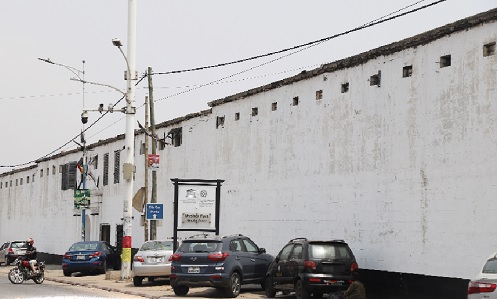On the shores of Accra, somewhere on the John Atta Mills Highway near Bukom stands the bastion of the Dutch Stone Fort Crevecoeur, built in 1649.
The British captured this fort after heavy bombardments in the Fourth Anglo-Dutch War of 1780-1784 and built upon it to become the Ussher Fort Prison.
Named in honour of the then Administrator of the Gold Coast, Herbert Taylor Ussher, the prison is known to have caged some prominent political prisoners, including former President John Agyekum Kufuor.
![]()
The bastion of Fort Crevecoeur built in 1649. This is the only part left after bombardments by the British between 1780 and 1784
The prison is an exemplar of the typical British colonial design of prisons in the African sub-region.
When The Mirror visited the fort last Wednesday, Senior Conservator of Monuments at the board’s head office, Mr Benjamin Afagbegee, said the prison had served many functions in the country’s political history.
![]()
This drawing cabinet used for storing pictures/ drawings is more than 20 years old
He said that even though purposely built as a prison by the British colonialists, it had not only been used as a state prison run by the Ghana Prisons Service but also as a Refugee Camp housing refugees from the Darfur war in Sudan.
As he took The Mirror on a tour of the fort, he pointed out some writings on the walls of some parts of the fort, which authenticated his narrative.
![]()
Arabic inscriptions made by refugees from Sudan during the Darfur war
The fort also houses the Museum of Slavery, which exhibits some artefacts and facts about the Transatlantic Slave Trade.
The fort now stands as one of the castles and forts protected as a national monument under the National Liberation Council Decree (NLCD) 387 of 1969 and Executive Instrument (EI) 29 of 1973 and in the custody of the Ghana Museums and Monuments Board (GMMB).
![]()
A canon found at sea by fishermen and brought to the museum
It is a place where both local and foreign researchers, students and tourists visit to learn and gain a better understanding of history.
Mr Afagbegee said the prison was formally handed over to the board in the year 2000 when it was no longer fit for purpose.
![]()
Mr Benjamin Afagbegee, Senior Conservator of Monuments explaining how the slave bounds were used
According to him, the prisoners were sent to the Ankaful Prison in the Central Region and The Nsawam Prison in the Eastern Region.
Mr Afagbegee, who is an architect, said the fort, which is one of the 28 listed by UNESCO in the country as World Heritage sites, was also historically linked to the traditional community of the Ussher town.
![]()
Some artefacts on display
He showed this journalist an inner courtyard where he said traditional priests (wulomei) and chiefs of the town performed rituals and sprinkled Kpokpoi, (the traditional meal made from maize) during Homowo festivals.
At the bastion of Fort Crevecouer, this journalist observed the point at which the old stones meet the new blocks adding to the prison building.
![]()
Mr Benjamin Afagbegee (right), Senior Conservator of Monuments explaining to Doreen Hammond, Editor of The Mirror, features of the prison architecture, during a tour of the facility
The Mirror saw very old items, including a canon, which Mr Afagbegee said fishermen found at sea and brought to the fort.
There were threats to the preservation of the fort as the fabric of the building was deteriorating and some blocks hung loosely.
![]()
Filth thrown into the sea redeposited on the seashore
According to Mr Afagbegee, this was partly due to the environmental conditions, including the saline air and moisture. There were some fallen blocks from the building and some very old items, including a canon, which fishermen found at sea and brought to the fort.
Looking at the seashore while standing at the bastion, a heavy carpet of filth largely composed of plastics and washed ashore, lined the beach.
![]()
A church and mosque within the prison
Some people from the community were seen squatting on the beach attending to the call of nature, a scene which did not befit the status of the fort as a tourist site.
Some squatters had made some parts of the fort their home and, according to Mr Afagbegee, several warnings to them to leave the premises had yielded no fruit.
![]()
Latrines used by the prisoners
Mr Afagbegee said that even though some funding had been secured to renovate some parts of the fort, more help was needed to preserve the integrity and authenticity of the fort.
He also noted that information on the history of the fort was incomplete for the whole period of its existence and needed further study even with additional Ghanaian documentation for the purpose.
The country has many historical and tourist sites which need development to make them more attractive to earn the country the much-needed revenue.
Ussher Fort Prison is definitely one of them.
Writer’s e-mail : aamakai@rocketmail.com / doreen.hammond@graphic.com.gh

